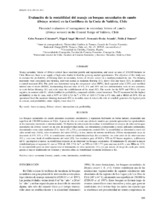Mostrar el registro sencillo del ítem
Evaluación de la rentabilidad del manejo en bosques secundarios de canelo (Drimys winteri) en la Cordillera de la Costa de Valdivia, Chile
| dc.contributor.author | Navarro Cárcamo, Celso | |
| dc.contributor.author | Herrera Machuca, Miguel Ángel | |
| dc.contributor.author | Drake Aranda, Fernando | |
| dc.contributor.author | Donoso, Pablo J. | |
| dc.date.accessioned | 2012-10-25T12:40:32Z | |
| dc.date.available | 2012-10-25T12:40:32Z | |
| dc.date.issued | 2010 | |
| dc.identifier.uri | http://hdl.handle.net/10396/8102 | |
| dc.description.abstract | Young secondary forests of Drimys winteri have excellent growth and regeneration, and cover an area of 230,000 hectares in Chile. However, there is no supply of high-value timber to feed the growing market opportunities. The objective of this study was to evaluate the profitability of thinning trials in secondary forests of Drymis winteri in a medium-productivity site. The thinning treatments were considered late thinning, and were named as moderate thinning (E1), heavy (E2) and heavy (E3), in addition to a control treatment (E4). The yield was determined using the net present value (NPV), land expected value (LEV), and modified internal rate of return (MIRR), incorporating discount rates of 6 %, 8 % and 10 % and low administration costs in two scenarios, no costs before thinning (S1) and costs since the establishment of the stand (S2). The results for the NPV and VPS in S2 were negative, in contrast with S1, which doubled its profitability compared with the control treatment. The E2 treatment had the highest profitability in the S1 case, with a NPV of USD 2,724 ha–1, a VPS of USD 3,771 for a 6 % rate, and a MIRR of 19 %. For an operational level the moderate thinning treatment (E1) is desirable since it reduces the risk of windfall, generates the highest yield in volume, and profitability values slightly lower than E2. | es_ES |
| dc.description.abstract | Los bosques secundarios de canelo presentan excelentes crecimientos y regeneran fácilmente en forma natural, alcanzando una superficie de 230.000 hectáreas en Chile. A pesar de ello, no existe una oferta de madera que permita aprovechar las oportunidades de los mercados nacionales e internacionales. El objetivo de este estudio fue evaluar la rentabilidad de ensayos de raleo en bosques secundarios de Drimys winteri en un sitio de productividad media. Los tratamientos corresponden a raleos aplicados tardíamente, denominados como raleo moderado (E1), fuerte (E2 y E3) y un tratamiento control (E4). La rentabilidad se determinó a través del valor actual neto (VAN), valor económico del suelo (VES) y la tasa interna de retorno modificada (TIRm) incorporando tasas de descuento de 6 %, 8 % y 10 %; se consideraron costos de administración bajo dos escenarios: sin costo antes de las intervenciones (S1) y con costo desde el establecimiento del rodal (S2). Los resultados para el VAN y VPS en S2 fueron negativos, a diferencia del S1 que duplicó al menos su rentabilidad respecto de no intervenir los bosques secundarios. El tratamiento E2 presentó la mayor rentabilidad para el supuesto S1 con un VAN de US$ 2.724 ha–1, un VPS de US$ 3.771 para una tasa de 6 % y una TIRm de 19 %. Es recomendable para un nivel operacional el tratamiento de raleo moderado (E1), ya que reduce el riesgo de caída por viento, genera el mayor rendimiento en volumen y presenta cifras de rentabilidad levemente inferiores a E2. | es_ES |
| dc.format.mimetype | application/pdf | es_ES |
| dc.language.iso | spa | es_ES |
| dc.publisher | Universidad Austral de Chile | es_ES |
| dc.rights | https://creativecommons.org/licenses/by-nc-nd/4.0/ | es_ES |
| dc.source | Bosque 31 (3), 209-218 (2010) | es_ES |
| dc.subject | Economía forestal | es_ES |
| dc.subject | Canelo | es_ES |
| dc.subject | Cortas intermedias | es_ES |
| dc.subject | Rentabilidad | es_ES |
| dc.subject | Drimys winteri | es_ES |
| dc.subject | Forest economy | es_ES |
| dc.subject | Intermediate cut | es_ES |
| dc.title | Evaluación de la rentabilidad del manejo en bosques secundarios de canelo (Drimys winteri) en la Cordillera de la Costa de Valdivia, Chile | es_ES |
| dc.title.alternative | Financial evaluation of management in secondary forests of canelo (Drimys winteri) in the Coastal Range of Valdivia, Chile | es_ES |
| dc.type | info:eu-repo/semantics/article | es_ES |
| dc.rights.accessRights | info:eu-repo/semantics/openAccess | es_ES |

